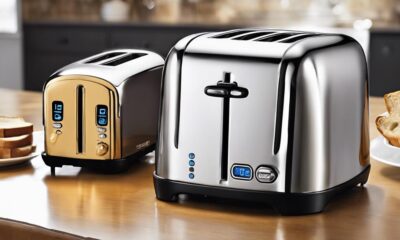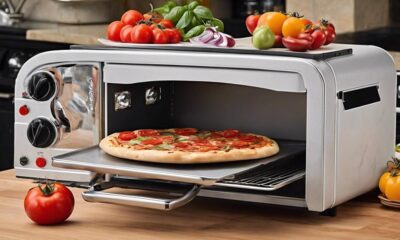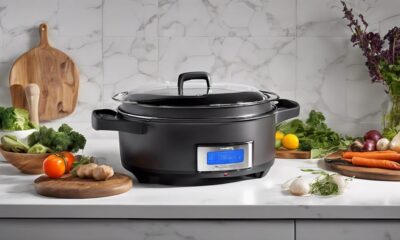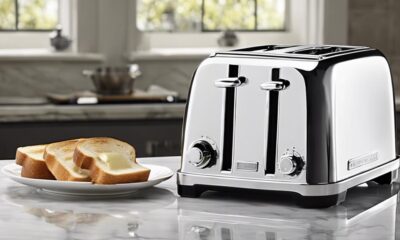Expert
What Electric Appliances Use the Most Electricity
2025

To effectively identify which electric appliances use the most electricity, it is crucial to have a thorough understanding of the different devices typically found in homes. This understanding is especially important for those looking to efficiently manage their energy usage.
By identifying the appliances that contribute significantly to electricity usage, one can make informed decisions to optimize energy efficiency and reduce costs. This article aims to shed light on the appliances that have the highest energy consumption, including air conditioners, water heaters, clothes dryers, electric furnaces, electric stoves and ovens, electric kettles, space heaters, pool pumps, and electric vehicles.
By recognizing these power-intensive appliances, individuals can take proactive steps towards a more sustainable and economical energy usage approach.
Key Takeaways
- Air conditioners consume a significant amount of electricity, and their energy consumption depends on factors such as unit size, system efficiency, and climate.
- Water heaters account for a significant portion of energy usage in households, and energy-efficient options such as tankless or solar-powered water heaters can minimize energy consumption and reduce costs.
- Clothes dryers are energy-intensive appliances, but using energy-efficient alternatives such as heat pump dryers or traditional clotheslines can help reduce electricity consumption.
- Choosing energy-efficient appliances, adopting energy-saving practices, and being mindful of energy usage can help lower overall energy consumption and contribute to cost savings and a more sustainable approach to energy consumption.
Air Conditioners
Air conditioners are among the electric appliances that consume the highest amount of electricity. The energy consumption of air conditioners can vary depending on several factors, including the size of the unit, the efficiency of the system, and the climate in which it is used.

In general, air conditioners are designed to cool indoor spaces by removing heat from the air and expelling it outside. This process requires a significant amount of energy, especially during hot summer months.
Additionally, air conditioners require regular maintenance to ensure optimal performance and energy efficiency. This includes cleaning or replacing filters, checking refrigerant levels, and inspecting the overall condition of the unit. Neglecting proper maintenance can lead to reduced efficiency and increased energy consumption, as well as higher maintenance costs in the long run.
Transitioning into the subsequent section about water heaters, it is important to note that they also contribute to high energy consumption in households.
Water Heaters
Water heaters are a crucial appliance in many households, accounting for a significant portion of energy usage.

To address this, energy-efficient water heaters have been developed to minimize energy consumption and reduce costs.
Additionally, exploring alternatives to traditional water heaters, such as tankless or solar-powered options, can further optimize energy efficiency and sustainability.
Energy-Efficient Water Heaters
Energy-efficient water heaters are one of the most electricity-consuming appliances in households. Traditional water heaters are known for their high energy consumption and inefficiency. However, energy-efficient water heaters offer a solution to this problem.
These water heaters are designed to minimize energy wastage and maximize performance. They utilize advanced technologies such as heat pumps, condensing technology, and improved insulation to reduce energy consumption.

The benefits of energy-efficient water heaters include lower energy bills, reduced greenhouse gas emissions, and longer lifespan. By using less electricity, these water heaters help homeowners save money while also contributing to a more sustainable environment.
Therefore, investing in energy-efficient water heaters is a wise choice for those looking to reduce their energy consumption and carbon footprint.
Now, let’s explore the alternatives to traditional water heaters.
Alternatives to Water Heaters?
One alternative to traditional water heaters is the use of heat pump technology. Heat pumps are energy efficient alternatives that can provide hot water for household use. They work by extracting heat from the air or ground and transferring it to the water, using significantly less energy compared to conventional water heaters.

To provide a cost-effective option for homeowners, heat pump water heaters come with various benefits:
- Energy savings: Heat pumps can reduce energy consumption by up to 60% compared to conventional water heaters, resulting in lower utility bills.
- Environmental friendliness: By utilizing renewable energy sources, such as air or ground heat, heat pump water heaters contribute to reducing greenhouse gas emissions.
- Long-term savings: Although heat pump water heaters may have a higher upfront cost, their energy efficiency and durability can lead to significant long-term savings.
Considering the energy-efficient alternatives and cost-effective options available, heat pump technology is a viable choice when considering alternatives to traditional water heaters.
Clothes Dryers
Clothes dryers are one of the most energy-intensive appliances in households.
However, there are energy-efficient alternatives available that can help reduce electricity consumption.

These alternatives include heat pump dryers, which use significantly less energy than traditional electric dryers.
Energy-Efficient Dryer Alternatives
What alternative appliances can be used for drying clothes that consume less electricity?
When it comes to energy-efficient dryer options, there are alternatives that can significantly contribute to reducing energy consumption in laundry. Here are three options to consider:
- Clotheslines: Traditional clotheslines are the most energy-efficient way to dry clothes. By utilizing solar and wind energy, clotheslines eliminate the need for electricity altogether. Not only does this reduce your carbon footprint, but it also saves on utility bills.
- Drying Racks: Indoor drying racks are convenient alternatives to electric dryers. They provide ample space to hang clothes and allow them to air dry naturally. Drying racks are especially suitable for delicate garments that require gentle drying.
- Spin Dryers: Spin dryers are compact appliances that use centrifugal force to extract excess moisture from clothes. They require much less energy compared to traditional electric dryers and are ideal for small spaces.
Impact on Electricity Bill
The electricity consumption of electric dryers can have a significant impact on monthly utility bills. Clothes dryers are one of the most energy-intensive appliances in a household, often accounting for a large portion of the electricity bill.

To reduce electricity bills, it is important to employ energy-saving tips specifically for clothes dryers. One approach is to ensure that the dryer is fully loaded each time it is used. This maximizes the efficiency of the dryer and reduces the number of cycles required.
Another effective tip is to use the moisture sensor feature if available, which automatically shuts off the dryer when the clothes are dry. Regular maintenance, such as cleaning the lint filter and ensuring proper ventilation, is also crucial for optimal performance and energy efficiency.
Monitoring energy consumption is essential for cost savings, as it allows homeowners to identify areas of high energy usage and make necessary adjustments. By implementing these energy-saving strategies and closely monitoring energy consumption, households can significantly reduce their electricity bills.
Electric Furnaces
Electric furnaces are energy-intensive devices that are commonly used for heating residential and commercial spaces. These appliances require regular maintenance to ensure their efficient operation and longevity.

Here are three key benefits of electric furnaces:
- Energy Efficiency: Electric furnaces have high energy efficiency ratings, making them a cost-effective option for heating. They convert almost all the electricity they consume into heat, minimizing wasted energy.
- Environmental Friendliness: Electric furnaces do not produce any greenhouse gas emissions during operation, unlike furnaces that use fossil fuels such as oil or gas. This makes them a cleaner and more eco-friendly heating option.
- Safety: Electric furnaces do not use combustion to generate heat, eliminating the risk of carbon monoxide leaks. Additionally, they do not require any fuel storage, reducing the potential for accidents or fires.
Regular electric furnace maintenance, including filter cleaning and inspection by a professional technician, is crucial to ensure optimal performance and energy efficiency.
Electric Stoves and Ovens
Electric stoves and ovens consume significant amounts of electricity to efficiently cook and bake food. When it comes to electric stove safety, there are several factors to consider.
First, ensure that the stove is properly installed and grounded to prevent electrical shocks. It’s important to keep the stove clean and free from any spills or debris that could potentially cause a fire. Additionally, always use caution when handling hot pots and pans to avoid burns or accidents.

Now, let’s discuss the benefits of electric ovens. Electric ovens offer precise temperature control, allowing for consistent and even cooking. They also heat up quickly and provide a more stable cooking environment. Furthermore, electric ovens are often more energy-efficient compared to their gas counterparts, resulting in lower energy bills.
Refrigerators
Refrigerators are one of the most power-hungry household appliances, consuming a significant amount of electricity. To help you make informed choices and reduce your energy consumption, here are three important points to consider:
- Energy efficient refrigerator options: When purchasing a new refrigerator, look for models that are ENERGY STAR certified. These appliances are designed to consume less energy without compromising performance. They often incorporate features like improved insulation, LED lighting, and smart temperature controls.
- Proper refrigerator maintenance: Regular maintenance can ensure the optimal performance of your refrigerator. Clean the condenser coils at least twice a year to remove dust and debris, which can hinder heat transfer and increase energy consumption. Additionally, check the door seals for any leaks and replace them if necessary to maintain proper temperature control.
- Temperature settings: Set your refrigerator temperature to the manufacturer’s recommended level, typically between 35 and 38 degrees Fahrenheit (1.7 to 3.3 degrees Celsius). Avoid setting it lower than necessary, as every degree decrease can significantly increase energy usage.
Freezers
Freezers, another power-intensive household appliance, also consume a significant amount of electricity. These appliances are designed to maintain a low temperature for the purpose of preserving food items for extended periods. The energy consumption of freezers is primarily attributed to the need for continuous temperature control.
Freezers work by removing heat from the storage compartment and dissipating it into the surrounding environment. This process requires the operation of a compressor, which compresses and expands a refrigerant gas to transfer heat. The compressor is responsible for the majority of the energy consumption in a freezer.

Additionally, the insulation of the freezer plays a crucial role in its energy efficiency. Well-insulated freezers minimize heat exchange with the surroundings, reducing the energy required for temperature control.
Dishwashers
Furthermore, another household appliance that consumes a substantial amount of electricity is the dishwasher, which is closely related to freezers in terms of power consumption.
When it comes to energy efficiency, not all dishwashers are created equal. Here are three key factors to consider:
- Energy efficient dishwasher options: Look for dishwashers with an Energy Star rating, as these models meet strict energy efficiency guidelines set by the Environmental Protection Agency. They are designed to use less water and electricity, saving you money on utility bills.
- Impact of dishwashers on water consumption: Traditional dishwashers can use up to 10 gallons of water per cycle, while newer models with efficient water usage features can reduce water consumption to as little as 3 gallons per cycle. This not only helps to conserve water but also reduces the energy needed to heat the water.
- Cycle options and settings: Some dishwashers offer eco-friendly or energy-saving cycles that use less water and electricity. Additionally, choosing a dishwasher with adjustable settings allows you to customize the cleaning process based on the load size and level of dirtiness, further optimizing energy consumption.
Considering these factors can help you make an informed decision when choosing an energy-efficient dishwasher that not only saves electricity but also minimizes its impact on water consumption.

With this knowledge, let’s now move on to the next household appliance: washing machines.
Washing Machines
When it comes to energy-efficient washing machines, consumers have a variety of options to choose from. These machines are designed to reduce electricity consumption and water usage, making them a more sustainable choice.
Additionally, it is important to consider the environmental impact of washing machines, as they can contribute to water and air pollution.
As alternatives to traditional washing machines, some individuals may opt for hand-washing or using laundromats to reduce their energy consumption.

Energy-Efficient Washing Machines
Energy-efficient washing machines, designed to minimize electricity consumption, are becoming increasingly popular among environmentally-conscious consumers. These modern appliances offer several benefits, making them a wise choice for those looking to reduce their energy usage and environmental footprint.
Here are three reasons why energy-efficient washing machines are a great investment:
- Energy saving laundry techniques: Energy-efficient washing machines incorporate advanced technologies such as sensors that adjust water levels and cycle times based on the load size. This ensures optimal energy usage and reduces unnecessary wastage.
- Benefits of front loading washing machines: Front loading machines are known for their energy efficiency. They use less water, detergent, and electricity compared to top-loading machines. Additionally, their design allows for higher spin speeds, resulting in faster drying times and further energy savings.
- Cost savings: While energy-efficient washing machines may have a higher upfront cost, they offer significant savings in the long run. With reduced electricity consumption, users can expect lower utility bills, resulting in cost savings over time.
These energy-efficient washing machines not only help individuals save money but also contribute to a greener environment.
Environmental Impact of Washing
To understand the environmental impact of washing machines, it is important to consider their energy consumption and water usage.

Washing machines have made our lives easier by automating the laundry process, but they also have a significant impact on the environment.
The energy consumption of washing machines varies depending on the model and settings used. Additionally, water consumption is a major concern, as washing machines use a significant amount of water for each cycle.
The environmental impact of detergent should also be taken into account, as some chemicals in detergents can be harmful to aquatic life when they enter the water supply.
Considering these factors, it is crucial to explore alternatives to traditional washing machines that can minimize their environmental impact.

Alternatives to Washing Machines?
The environmental impact of washing machines prompts the exploration of alternative options to traditional washing machines. While washing machines offer convenience and efficiency, they consume significant amounts of water and energy. By considering alternatives, individuals can reduce their ecological footprint and embrace more sustainable practices.
Here are three alternatives to traditional washing machines:
- Handwashing: This method requires manual effort but offers numerous benefits. It allows for greater control over the cleaning process, reducing the risk of damage to delicate fabrics. Handwashing also requires less water and energy, making it a more environmentally friendly option.
- Portable washing machines: These compact devices are ideal for small living spaces or individuals who frequently travel. They use less water and have lower energy consumption compared to traditional washing machines.
- Laundry services: Utilizing laundry services, such as laundromats or drop-off services, can be a convenient alternative to owning a washing machine. These services often use more efficient machines and may offer environmentally friendly detergents.
Microwaves
Microwaves consume a significant amount of electricity due to their high wattage and usage frequency. When it comes to microwave safety, it is important to follow certain guidelines to prevent accidents and ensure optimal performance.
Firstly, it is crucial to avoid using metal or aluminum foil inside the microwave, as they can cause sparks and damage the appliance.

It is also recommended to use microwave-safe containers and covers to prevent leakage or contamination.
Additionally, it is advisable to stir or rotate food during cooking to ensure even heating and to avoid potential hot spots.
To maximize energy efficiency, it is recommended to use the appropriate power level for different types of food and to avoid excessive cooking times.
Electric Kettles
Electric kettles are a common appliance in households, but their energy consumption can vary depending on their efficiency. To reduce electricity consumption, consumers can opt for energy-efficient kettle options that are designed to use less power without compromising performance.

Energy-Efficient Kettle Options
When considering energy-efficient kettle options, it is crucial to understand their impact on electricity bills. By opting for an energy-efficient kettle, you can reduce your electricity consumption and save money in the long run.
Here are three reasons why investing in an energy-efficient kettle is a wise choice:
- Lower energy consumption: Energy-efficient kettles are designed to heat water quickly and efficiently, using less electricity than standard kettles.
- Reduced standby power: Energy-efficient kettles have minimal standby power, meaning they consume less energy when not in use.
- Temperature control features: Many energy-efficient kettles offer temperature control settings, allowing you to heat water to your desired temperature precisely.
Choosing an energy-efficient kettle can have a significant impact on your electricity bills, making it a worthwhile investment for those seeking to minimize their energy usage and maximize savings.
Impact on Electricity Bills
When considering the impact on electricity bills, it is important to examine the energy usage of electric kettles. Electric kettles are commonly used appliances in households and offices, but their energy consumption can vary depending on several factors.

The wattage of the kettle, the amount of water being heated, and the frequency of use all contribute to the overall energy consumption. To reduce the impact on energy consumption and save on electricity bills, there are several cost-saving measures that can be implemented.
For instance, choosing an electric kettle with a lower wattage can significantly reduce energy usage. Additionally, boiling only the necessary amount of water and avoiding unnecessary reboiling can also help in conserving energy.
Space Heaters
Space heaters consume a significant amount of energy and are known for their high electricity usage. When considering energy consumption, it is essential to be aware of the impact space heaters can have on your electricity bills. Here are three key points to consider:
- Energy Efficiency: Space heaters vary in their energy efficiency ratings. Look for models that are Energy Star certified, as they meet strict energy efficiency guidelines set by the Environmental Protection Agency. These heaters are designed to save energy and reduce electricity usage.
- Heating Capacity: The size and heating capacity of a space heater play a crucial role in its energy consumption. Choosing the right size heater for your space ensures optimal heating efficiency and reduces unnecessary energy waste.
- Safety Measures: Space heaters can pose safety risks if not used properly. Always follow safety guidelines, such as keeping heaters away from flammable materials, using them in well-ventilated areas, and never leaving them unattended. Additionally, consider investing in models with safety features like tip-over protection and overheat protection.
Pool Pumps
Pool pumps are another major contributor to high electricity usage in households. These pumps are essential for circulating water in the pool, but they can consume a significant amount of energy.

Fortunately, there are alternatives to traditional pool pumps that can help reduce electricity consumption. One option is to use a variable-speed pool pump, which allows for adjusting the pump’s speed based on the pool’s needs. This can result in significant energy savings compared to single-speed pumps.
Another energy-saving pool pump option is the use of high-efficiency pumps, which are designed to operate more efficiently and consume less electricity.
Additionally, installing a pool timer can help control the pump’s usage and reduce energy waste.
Electric Vehicles
Electric vehicles are becoming increasingly popular, with a growing number of households opting for these energy-efficient cars. As the demand for electric vehicles rises, there are two key factors that need to be considered: electric vehicle charging infrastructure and range anxiety.

- Electric vehicle charging infrastructure: The availability and accessibility of charging stations play a crucial role in the adoption of electric vehicles. A well-developed charging infrastructure ensures that EV owners have convenient access to charging points, enabling them to travel longer distances without worry.
- Range anxiety in electric vehicles: One of the main concerns for potential EV owners is the fear of running out of battery power. Range anxiety refers to the anxiety or fear of not being able to reach their destination due to limited electric range. To address this issue, manufacturers are continuously improving battery technology to increase the range of electric vehicles and alleviate range anxiety.
- Battery charging time: Another aspect that affects the adoption of electric vehicles is the time it takes to charge the battery. Fast-charging technologies are being developed to reduce charging times and provide EV owners with a more convenient and efficient charging experience.
With advancements in charging infrastructure and battery technology, electric vehicles are becoming a viable option for more households, offering a sustainable and efficient mode of transportation.
Frequently Asked Questions
How Can I Reduce the Electricity Consumption of My Air Conditioner?
To reduce electricity consumption of an air conditioner, consider adjusting the thermostat to a higher temperature, ensuring proper insulation, cleaning or replacing air filters regularly, and utilizing ceiling fans for added cooling.
What Factors Should I Consider When Choosing a Water Heater for Energy Efficiency?
When choosing a water heater for energy efficiency, two important factors to consider are cost effectiveness and insulation quality. These factors play a crucial role in minimizing electricity consumption and maximizing energy savings.
Is It More Energy-Efficient to Dry Clothes Using a Clothes Dryer or by Air-Drying Them?
When comparing air drying and using a clothes dryer, it is important to consider the energy efficiency of each method. Air drying clothes is generally more energy-efficient as it does not require electricity to operate, resulting in lower energy consumption.

Are Electric Stoves and Ovens More Energy-Efficient Than Their Gas Counterparts?
Electric vs. gas stoves: which is more cost effective? Comparing the energy efficiency of electric and gas ovens, it is essential to consider factors such as fuel prices, insulation, and cooking habits to determine the most economical option.
Can I Save Energy by Adjusting the Temperature Settings of My Refrigerator and Freezer?
Adjusting the temperature settings of your refrigerator and freezer can lead to energy savings. By optimizing the temperature, you can reduce energy consumption without compromising the quality and safety of your stored food items.
Conclusion
In conclusion, it is evident that certain electric appliances consume a significant amount of electricity. Air conditioners, water heaters, clothes dryers, electric furnaces, stoves and ovens, kettles, space heaters, pool pumps, and electric vehicles are among the top consumers.
While some may argue that energy-efficient alternatives can mitigate this issue, it is crucial to acknowledge that these appliances are essential for modern living. Finding a balance between comfort and energy consumption is necessary.

Jules stands at the intersection of appliances and smart home technology, an area that’s rapidly gaining importance in modern homes. With a background in home technology integration, Jules specializes in how traditional appliances can work seamlessly with smart home systems to create more efficient, convenient, and tailored home environments. Jules’s articles provide a glimpse into the future of home living, offering advice on integrating smart technology into every aspect of your home life.

In today’s interconnected world, the demand for high-speed and reliable wireless connections has become paramount. With the advent of dual-band routers, users now have the option to connect their devices to either the 2.4GHz or 5GHz frequency bands.
However, understanding which devices are best suited for each frequency can be challenging. This article aims to provide clarity by outlining the types of devices that should ideally be connected to the 2.4GHz and 5GHz bands.
Whether it’s smartphones and tablets, laptops and desktop computers, smart TVs and streaming devices, or even home security systems and gaming consoles, each device has its own unique requirements that determine the most suitable frequency band for optimal performance.
By making informed decisions about device allocation, users can maximize their wireless network efficiency and enjoy seamless connectivity across their electronic ecosystem.

Key Takeaways
- Smartphones, tablets, laptops, and desktop computers can benefit from both the 2.4GHz and 5GHz networks, leveraging wider coverage range and faster speeds respectively for optimal performance and connectivity.
- Smart TVs, streaming devices, and gaming consoles should be connected to the 5GHz network for faster speeds, less interference, and optimal settings, ensuring better streaming quality and reduced latency for online gaming.
- Home security systems, wireless printers, wireless cameras/baby monitors, and Wi-Fi extenders/repeaters should be connected to the 2.4GHz network for better range, wider coverage, and compatibility with most protocols. Proper placement of extenders and repeaters should consider channel congestion, interference mitigation, and signal strength from the main router.
- IoT devices require optimal frequency selection, managing network congestion through QoS mechanisms, and addressing security concerns with firmware updates, strong authentication, access controls, and separate networks to improve data privacy.
Smartphones and Tablets
Smartphones and tablets are the primary devices that should be connected to both the 2.4GHz and 5GHz networks for optimal performance and flexibility. These devices rely heavily on internet connectivity for various tasks such as browsing, streaming, and downloading content. By connecting them to both networks, users can take advantage of the unique benefits that each frequency has to offer.
The 2.4GHz network provides a wider coverage range, making it ideal for devices that are farther away from the router. However, this frequency is often crowded, leading to potential connectivity issues in densely populated areas or areas with multiple Wi-Fi networks.
On the other hand, the 5GHz network offers faster speeds and less interference, making it suitable for data-intensive activities like video streaming or online gaming. However, its range may be shorter compared to the 2.4GHz network.
Laptops and Desktop Computers
Laptops and desktop computers, being essential devices for various tasks and online activities, also benefit from being connected to both the 2.4GHz and 5GHz networks. This allows users to leverage the advantages of each frequency band for optimal laptop performance and desktop connectivity.

Here are three key reasons why laptops and desktop computers should be connected to both networks:
- Speed and Performance: The 5GHz network offers higher speeds and lower latency compared to the 2.4GHz network. This is particularly important for bandwidth-intensive activities such as video streaming, online gaming, and large file transfers.
- Range and Compatibility: The 2.4GHz network provides better coverage and can penetrate through walls and obstacles more easily than the 5GHz network. This makes it suitable for devices located farther away from the router or in areas with interference.
- Device Compatibility: Some older laptops and desktop computers may only support the 2.4GHz network. By having both networks available, you can ensure compatibility with a wider range of devices and avoid potential connectivity issues.
Smart TVs and Streaming Devices
Continuing the discussion from the previous subtopic, it is important to consider which devices should be connected to the 2.4GHz and 5GHz networks, particularly when it comes to smart TVs and streaming devices. Smart TVs are becoming increasingly popular, offering a range of streaming options for users to enjoy their favorite shows and movies. To ensure optimal performance, it is recommended to connect smart TVs to the 5GHz network, as it provides faster speeds and less interference. Streaming devices, such as Roku, Apple TV, and Chromecast, are designed to work with both 2.4GHz and 5GHz networks. However, if your streaming device supports 5GHz, it is advisable to connect it to that network for better streaming quality.
| Device | Recommended Network |
|---|---|
| Smart TV | 5GHz |
| Roku | Both |
| Apple TV | Both |
| Chromecast | Both |
| Amazon Fire Stick | Both |
Home Security Systems
When considering the network allocation for home security systems, it is important to determine which devices should be connected to the 2.4GHz or 5GHz networks.
To ensure optimal placement and Wi-Fi security, here are three key devices to consider:

- Security Cameras: These devices typically require a stable and reliable connection to transmit video footage. It is recommended to connect security cameras to the 2.4GHz network as it offers better range and penetration through walls, ensuring uninterrupted monitoring.
- Alarm Systems: Alarm systems require constant connectivity to ensure timely notifications and responses. Connecting them to the 2.4GHz network is advisable, as it offers wider coverage and better compatibility with most alarm system protocols.
- Smart Door Locks: Smart door locks provide convenient access control, but they also need a reliable and secure connection. Connecting them to the 2.4GHz network is recommended, as it offers better range and stability for remote access and monitoring.
Gaming Consoles
Gaming consoles are devices that require careful consideration when determining the appropriate network allocation between 2.4GHz and 5GHz. To ensure optimal settings for gaming and reduce latency, it is recommended to connect gaming consoles to the 5GHz network. This frequency band offers faster data transfer rates and lower interference compared to the crowded 2.4GHz band. By utilizing the 5GHz network, gamers can experience smoother gameplay with minimal lag and latency issues.
Below is a table highlighting the key factors to consider when choosing the network allocation for gaming consoles:
| Factor | 2.4GHz Network | 5GHz Network |
|---|---|---|
| Data transfer rate | Slower | Faster |
| Interference | More susceptible | Less susceptible |
| Range | Longer | Shorter |
Smart Home Devices
To optimize the performance of smart home devices, careful consideration should be given to their network allocation between 2.4GHz and 5GHz. Smart home devices, such as smart speakers, thermostats, and security cameras, can benefit from being connected to the appropriate frequency band based on their specific requirements.
Here are three key factors to consider:

- Optimal Placement: Smart home devices that are located far away from the router or have obstacles in between may benefit from connecting to the 2.4GHz band. This frequency has a longer range and better ability to penetrate walls, ensuring a stable connection.
- Network Security: Devices that require a higher level of security, such as smart locks or security systems, should be connected to the 5GHz band. This band offers better encryption and less interference, making it more secure for transmitting sensitive data.
- Bandwidth Requirements: Devices that require high bandwidth, such as streaming devices or gaming consoles, should be allocated to the 5GHz band. This frequency offers faster speeds and can handle more data-intensive tasks.
Wireless Printers
Wireless printers, like other smart home devices, can benefit from careful consideration of their network allocation between 2.4GHz and 5GHz frequencies. When deciding which frequency to connect your wireless printer to, it is important to understand the advantages and limitations of each frequency band.
The 2.4GHz frequency provides a wider coverage area and better penetration through walls, making it suitable for printers located far from the router or in areas with obstacles. However, this frequency is more susceptible to interference from other devices, such as microwave ovens and cordless phones, which can affect printer performance.
On the other hand, the 5GHz frequency offers faster data transfer rates and is less crowded, resulting in more reliable and stable connections. However, it has a shorter range and may not reach printers located in distant areas of your home or office.
To effectively manage printer queues and troubleshoot printer connectivity issues, it is recommended to connect wireless printers to the 2.4GHz frequency. This ensures wider coverage and minimizes potential interference, providing a more seamless printing experience.

Transitioning to the subsequent section about ‘internet of things (iot) devices’, it is important to consider the network allocation for these devices as well, to optimize performance and connectivity.
Internet of Things (IoT) Devices
When it comes to Internet of Things (IoT) devices, choosing the optimal frequency for connectivity is crucial. Different IoT devices have varying bandwidth requirements, and selecting the appropriate frequency band, whether it is 2.4GHz or 5GHz, can ensure optimal performance and efficiency.
Additionally, managing network congestion is a significant concern in IoT deployments, as a large number of devices can strain the available bandwidth and impact overall network performance.
Lastly, security is a paramount concern in the IoT landscape, as these devices often collect and transmit sensitive data. This makes it essential to implement robust security measures to protect against potential breaches.

Optimal Frequency for Iot
While determining the optimal frequency for IoT devices, it is essential to consider their specific requirements and network capabilities. Here are three important factors to consider:
- Network Capacity: IoT devices generate a significant amount of network traffic, and it is crucial to manage this traffic effectively. By choosing the optimal frequency, you can ensure that the available bandwidth is utilized efficiently, minimizing congestion and maximizing performance.
- Interference Mitigation: IoT devices often operate in environments with numerous wireless devices. Choosing the right frequency can help minimize interference from neighboring devices, ensuring reliable and uninterrupted connectivity for IoT devices.
- Security Considerations: Best practices for securing IoT devices recommend using separate networks for IoT devices and other devices such as computers or smartphones. By assigning IoT devices to a specific frequency, you can isolate them from other devices, enhancing network security and reducing the risk of unauthorized access.
Managing Iot Network Congestion
To effectively manage network congestion for IoT devices, it is crucial to implement strategies that optimize bandwidth utilization and minimize disruptions caused by excessive traffic.
With the growing number of IoT devices connected to networks, managing congestion has become a critical concern. One way to address this issue is by implementing Quality of Service (QoS) mechanisms that prioritize important IoT traffic and allocate bandwidth accordingly. This ensures that critical IoT applications, such as real-time monitoring or security systems, receive the necessary network resources for optimal performance.
Additionally, network administrators can employ traffic shaping techniques to regulate the flow of data and prevent congestion.

Security Concerns With Iot
Implementing robust security measures is essential for protecting IoT devices from potential threats and ensuring the integrity and privacy of sensitive data. The increasing number of IoT devices connected to networks has made them attractive targets for cyberattacks.
To effectively manage IoT device vulnerabilities and secure IoT data transmissions, the following measures should be considered:
- Regular firmware updates: Keeping IoT device firmware up to date is crucial for patching security vulnerabilities and ensuring devices are protected against the latest threats.
- Strong authentication and access controls: Implementing strong authentication mechanisms, such as two-factor authentication, and enforcing strict access controls can prevent unauthorized access to IoT devices and data.
- Secure data transmission protocols: Using encryption protocols such as Transport Layer Security (TLS) or Secure Shell (SSH) can protect IoT data during transmission, ensuring confidentiality and integrity.
Smart Speakers and Voice Assistants
Smart speakers and voice assistants should be connected to both the 2.4ghz and 5ghz networks for optimal performance and seamless connectivity. Managing privacy and ensuring voice recognition accuracy are crucial aspects of these devices.
By connecting to both networks, smart speakers can take advantage of the benefits offered by each frequency band. The 2.4ghz band provides better coverage and can penetrate walls and obstacles more effectively, ensuring a stable connection throughout the house.

On the other hand, the 5ghz band offers faster speeds and lower interference, resulting in improved voice recognition accuracy and responsiveness.
Wireless Cameras and Baby Monitors
Wireless cameras and baby monitors should be connected to either the 2.4ghz or 5ghz network for optimal performance and reliable surveillance. Here are three reasons why:
- Managing Interference: The 2.4ghz frequency band is more crowded and susceptible to interference from other devices like cordless phones and microwaves. By connecting wireless cameras and baby monitors to the 5ghz network, you can avoid interference and ensure a stable connection.
- Range Limitations: The 2.4ghz frequency band has a longer range compared to 5ghz. This makes it suitable for devices that require a wider coverage area, such as baby monitors. However, if you need higher data transfer speeds and don’t require long-range coverage, the 5ghz network is a better choice.
- Bandwidth Requirements: Wireless cameras often require a significant amount of bandwidth to transmit high-quality video footage. The 5ghz network offers faster data transfer speeds, making it ideal for streaming high-definition video without buffering or lag.
Wi-Fi Extenders and Repeaters
When it comes to Wi-Fi extenders and repeaters, there are several key points to consider.
First, the placement of these devices is crucial for optimal coverage and signal strength.

Additionally, compatibility with the existing network is important to ensure seamless integration.
Finally, bandwidth allocation and prioritization features can help manage network traffic effectively.
These factors should be carefully evaluated when setting up Wi-Fi extenders and repeaters to enhance wireless connectivity.
Placement for Optimal Coverage
For optimal coverage, it is important to consider the placement of Wi-Fi extenders and repeaters within the network infrastructure. Here are three key considerations:

- Optimal Channel Selection: When positioning Wi-Fi extenders and repeaters, it is crucial to ensure they are placed on channels that are not already congested. By selecting channels with less interference, you can maximize the efficiency and performance of your network.
- Interference Mitigation: Avoid placing Wi-Fi extenders and repeaters near sources of interference, such as cordless phones, microwave ovens, or other electronic devices. These can disrupt the signal and degrade the overall coverage and performance of your network.
- Strategic Placement: Place Wi-Fi extenders and repeaters in areas where the signal strength from the main router is still strong but may be weaker or nonexistent. This helps to extend the coverage to dead spots or areas with weak signal strength.
By considering these factors, you can optimize the placement of Wi-Fi extenders and repeaters for optimal coverage and performance.
Now, let’s delve into the next section, which discusses the compatibility of these devices with the existing network.
Compatibility With Existing Network
To ensure optimal compatibility with the existing network, it is essential to consider the frequency band selection for Wi-Fi extenders and repeaters. These devices are designed to amplify and extend the reach of the existing Wi-Fi network, providing coverage to areas that may have weak signal strength.
When selecting the frequency band for these devices, it is important to choose the optimal channel selection to avoid interference and ensure seamless connectivity. The 2.4GHz frequency band offers a longer range but is more susceptible to interference from other devices such as cordless phones and microwaves. On the other hand, the 5GHz frequency band provides faster speeds but has a shorter range.

Bandwidth Allocation and Prioritization
Optimal bandwidth allocation and prioritization is crucial for ensuring efficient performance of Wi-Fi extenders and repeaters, seamlessly extending the reach and coverage of the existing network. To achieve effective bandwidth management and network optimization, consider the following:
- Traffic prioritization:
Prioritizing specific types of network traffic can help ensure that critical applications, such as video streaming or online gaming, receive the necessary bandwidth. This can be achieved through Quality of Service (QoS) settings, which allow you to give priority to certain devices or applications. - Bandwidth allocation:
Allocating bandwidth between different devices and users is essential to prevent congestion and ensure a smooth browsing experience. This can be done through techniques like bandwidth shaping, where you can limit the maximum bandwidth available to certain devices or users. - Channel selection:
Choosing the right Wi-Fi channel is important to avoid interference and optimize network performance. Wi-Fi analyzers can help identify the least congested channels in your area, allowing you to select the most suitable one for your extender or repeater.
Frequently Asked Questions
Can I Connect My Gaming Console to Both the 2.4ghz and 5GHz Networks Simultaneously?
Yes, it is possible to connect a gaming console to both the 2.4GHz and 5GHz networks simultaneously. Similarly, smart speakers can be connected to both networks, while virtual reality headsets can be used on either network.
Are There Any Security Concerns With Using Wireless Cameras and Baby Monitors on the 2.4ghz or 5GHz Networks?
With regards to security concerns, wireless cameras and baby monitors should be connected to the 2.4GHz network as it provides better range and penetration. However, interference issues might arise due to the presence of other devices on the same frequency.
How Do Wi-Fi Extenders and Repeaters Work, and Which Frequency Should I Use for Optimal Performance?
Wi-Fi extenders and repeaters enhance wireless coverage by amplifying and rebroadcasting signals. Optimal performance depends on various factors, including the frequency used. For smart home devices, selecting the appropriate frequency is crucial for seamless connectivity and minimal interference.

Can I Connect My Wireless Printer to Both the 2.4ghz and 5GHz Networks to Print From Any Device?
It is possible to connect a wireless printer to both the 2.4GHz and 5GHz networks to enable printing from any device. Similarly, wireless headphones can be connected to either network, while accessing cloud storage is possible on both networks across different devices.
Are There Any Compatibility Issues With Connecting Iot Devices to Both the 2.4ghz and 5GHz Networks?
When connecting IoT devices to both the 2.4GHz and 5GHz networks, there may be compatibility issues due to differences in wireless protocols. Additionally, security concerns may arise with wireless cameras and baby monitors, requiring careful configuration and monitoring to mitigate risks.
Conclusion
In conclusion, determining which devices should be on the 2.4GHz or 5GHz frequency band is crucial for optimizing network performance. By allocating devices effectively, users can ensure smooth and efficient data transmission.
Understanding the capabilities and limitations of each frequency band is essential in achieving satisfactory connectivity for smartphones, tablets, laptops, smart TVs, gaming consoles, and various IoT devices.

Proper device allocation can greatly enhance the overall Wi-Fi experience, providing users with seamless connectivity and improved network stability.
With a keen eye for detail and a relentless pursuit of quality, Alex leads our editorial team. Bringing over a decade of experience in technology journalism and a deep passion for innovation, Alex ensures that Appliances Labs remains at the forefront of the industry. Under his leadership, our content meets and exceeds the highest accuracy, relevancy, and usefulness standards. Alex’s expertise in curating content that resonates with our readers has made Appliances Labs the go-to source for trustworthy appliance and smart home advice.
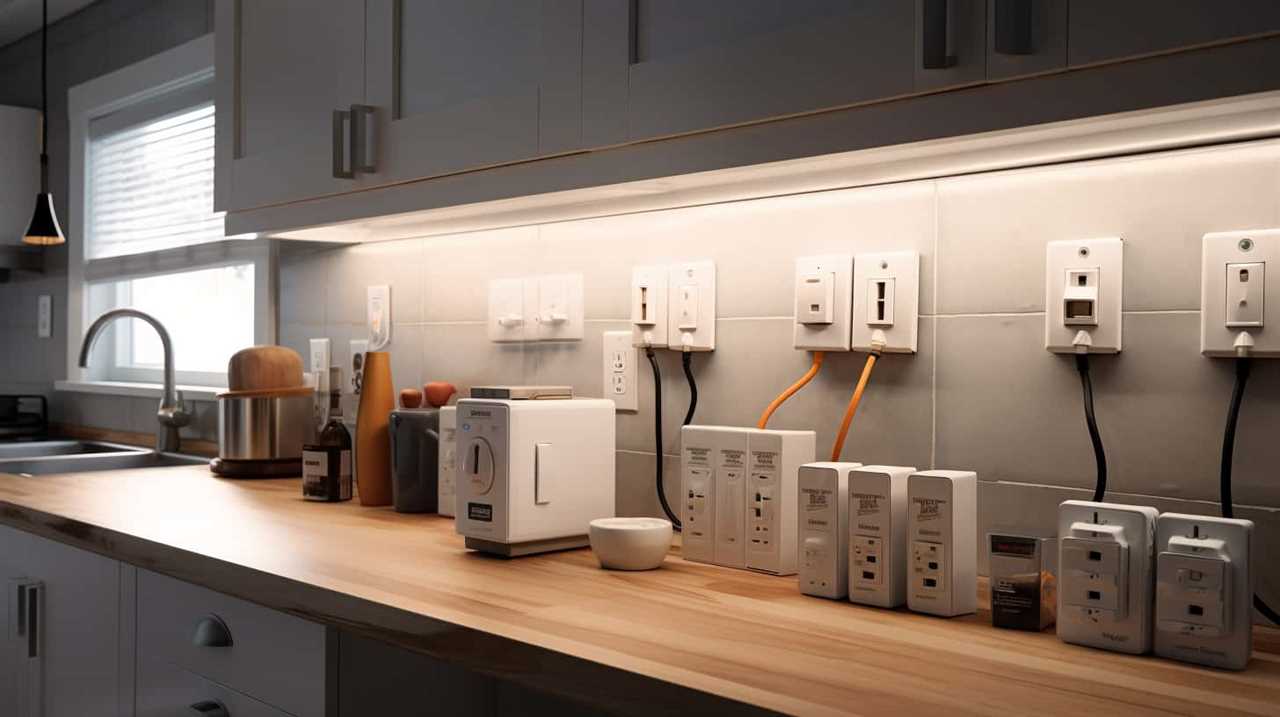
Smeg appliances, renowned for their exceptional craftsmanship and innovative design, are a household name in the realm of kitchen appliances. With a rich history that dates back to the 1940s, Smeg has carved a niche for itself in the industry by consistently delivering high-quality appliances that merge style and functionality seamlessly.
From refrigerators and ovens to dishwashers and coffee machines, Smeg offers a comprehensive range of kitchen appliances that cater to the diverse needs of homeowners and professional chefs alike. These appliances are characterized by their sleek aesthetics, cutting-edge technology, and intuitive features, making them a preferred choice for those who seek mastery in their culinary endeavors.
Choosing Smeg appliances not only elevates the visual appeal of your kitchen but also ensures optimal performance, energy efficiency, and durability. Whether you are a cooking enthusiast or a seasoned chef, Smeg appliances are designed to enhance your cooking experience and inspire culinary excellence.
With numerous authorized retailers worldwide, acquiring Smeg appliances is a hassle-free endeavor, allowing you to bring sophistication and functionality into your kitchen.

Key Takeaways
- Smeg Appliances are a leading brand in the kitchen appliance industry, known for their innovation, stylish design, and commitment to meeting consumer needs.
- Their comprehensive range of high-quality and innovative appliances includes refrigerators, ovens, dishwashers, and coffee machines, making them a preferred choice for homeowners and professional chefs.
- Smeg Appliances are known for their iconic retro-inspired designs, which add elegance and sophistication to any kitchen. They offer a variety of sizes and configurations to suit different kitchen layouts and needs.
- Some key benefits of Smeg Appliances include energy efficiency, user-friendly designs, durability, and compatibility with modern kitchen designs. They also feature exceptional performance, sleek design, innovative technology, and high-quality materials for enhanced functionality and convenience.
History of Smeg Appliances
The origins of Smeg appliances can be traced back to the mid-20th century when the company was founded in Italy. Since its inception, Smeg has undergone a significant evolution, becoming a prominent player in the world of kitchen appliances.
Over the years, Smeg appliances have continuously adapted to meet the changing needs and preferences of consumers. This evolution has been driven by a commitment to innovation and a keen understanding of the impact that appliances have on kitchen design. Smeg appliances have not only become more technologically advanced and efficient but have also become a design statement in their own right.
With their sleek lines, vibrant colors, and retro-inspired designs, Smeg appliances have had a profound impact on kitchen aesthetics, transforming them from purely functional spaces to stylish and inviting environments.
Range of Smeg Kitchen Appliances
Smeg offers a wide range of popular kitchen appliances that cater to different needs and preferences.

From refrigerators and ovens to dishwashers and coffee machines, Smeg appliances are known for their high quality and innovative features.
These appliances not only provide excellent performance but also add a touch of style and elegance to any kitchen, making them a popular choice among homeowners and professional chefs alike.
Popular Smeg Appliances
One of the most sought-after brands in the kitchen appliance industry, Smeg offers a wide range of popular appliances for the modern kitchen.
When it comes to Smeg toaster options, there are several models that stand out. The Smeg 2-Slice Toaster, for instance, features a retro design with a range of colors to choose from. It comes with extra-wide slots and multiple functions such as reheat, defrost, and bagel settings.

For those in need of a larger toaster, the Smeg 4-Slice Toaster is a great choice. It offers the same retro design and functions as the 2-slice model but with twice the capacity.
Moving on to Smeg refrigerator models, the brand is known for its iconic retro-style refrigerators. These refrigerators combine vintage aesthetics with modern functionality, featuring spacious interiors, adjustable shelves, and energy-efficient technology. Smeg also offers a variety of sizes and configurations to suit different kitchen layouts and needs.
Benefits of Smeg Appliances
Smeg appliances offer a range of benefits for users in the kitchen. Here are some key advantages of these appliances:
- Energy efficiency: Smeg appliances are designed to be energy-efficient, helping users save on their utility bills while reducing their carbon footprint.
- Ease of use: Smeg appliances are known for their user-friendly designs, making them easy to operate and navigate. Whether it’s a refrigerator, oven, or dishwasher, Smeg appliances are intuitive and straightforward to use.
- Durability: Smeg appliances are built to last, with high-quality materials and craftsmanship. These appliances are designed to withstand the demands of a busy kitchen and provide reliable performance over time.
- Stylish design: Smeg appliances are not only functional but also aesthetically pleasing. With their sleek and retro-inspired designs, these appliances can enhance the visual appeal of any kitchen.
Stylish Kitchen Appliance Options
A wide variety of stylish kitchen appliance options are available from the renowned brand, offering customers a range of choices to enhance the aesthetics of their kitchen.

Smeg appliances not only provide functional benefits but also add a touch of sophistication to any kitchen space. For those with small kitchens, Smeg appliances offer several advantages. Their compact designs ensure that they can fit seamlessly into limited spaces without compromising on performance.
Additionally, the sleek and modern look of Smeg appliances makes them perfect for incorporating into modern kitchen designs. Their clean lines and vibrant colors can serve as focal points or complement existing design elements.
Smeg appliances are not only reliable and efficient but also offer the opportunity to create a stylish and visually appealing kitchen environment.
Notable Features of Smeg Appliances
The distinguishing characteristics of Smeg appliances are their exceptional performance and sleek design. Smeg is known for its notable designs that combine classic aesthetics with a modern twist, making their appliances stand out in any kitchen. But it’s not just about looks; Smeg appliances also incorporate innovative technology to enhance functionality and convenience.

Here are some notable features that set Smeg appliances apart:
- High-quality materials: Smeg appliances are built using premium materials that ensure durability and longevity.
- Energy efficiency: Smeg appliances are designed to be energy-efficient, helping you save on utility bills while reducing your carbon footprint.
- Intuitive controls: Smeg appliances feature user-friendly interfaces and intuitive controls, making them easy to operate and navigate.
- Customization options: Smeg offers a wide range of customization options, allowing you to personalize your appliances to match your unique style and preferences.
These features combine to create appliances that not only perform exceptionally well but also add a touch of elegance to any kitchen space.
Benefits of Choosing Smeg Appliances
When it comes to the benefits of choosing Smeg appliances, there are several notable advantages.
Firstly, Smeg appliances are renowned for their stylish design, adding a touch of elegance to any kitchen.

Secondly, Smeg appliances are known for their high-quality performance features, ensuring reliability and efficiency.
Lastly, Smeg offers a diverse product range, catering to various needs and preferences.
Stylish Design Advantages
Choosing Smeg appliances offers the advantage of experiencing a stylish design that enhances the aesthetic appeal of any space.
Smeg appliances are known for their ability to incorporate stylish design trends while also incorporating innovative technology features. Here are some of the design advantages that come with choosing Smeg appliances:

- Timeless and sleek designs that never go out of style.
- Wide range of color options to match any kitchen or home decor.
- Attention to detail with high-quality materials and finishes.
- Unique retro-inspired designs that add a touch of nostalgia to any space.
With these design advantages, Smeg appliances not only provide functionality but also become a statement piece in any kitchen or living area.
Transitioning to the next section, let’s now explore the high-quality performance features that Smeg appliances offer.
High-Quality Performance Features
With their stylish design advantages, Smeg appliances seamlessly transition into high-quality performance features that provide exceptional benefits. Smeg is committed to delivering appliances that not only look good but also perform at the highest level. Through innovative technology and meticulous engineering, Smeg appliances offer a range of high-quality performance features that enhance the user experience.
One key aspect of Smeg appliances is their advanced functionality. Whether it’s a refrigerator with precise temperature control, a dishwasher with efficient cleaning capabilities, or an oven with multiple cooking modes, Smeg appliances are designed to make everyday tasks easier and more enjoyable.

In addition to their advanced functionality, Smeg appliances are known for their durability and reliability. Built with high-quality materials and rigorous testing, Smeg appliances are built to last, ensuring that you can rely on them for years to come.
To provide a comprehensive overview, the table below highlights some of the notable high-quality performance features found in Smeg appliances:
| Performance Feature | Benefit |
|---|---|
| Precise temperature control | Ensures optimal food preservation and freshness |
| Efficient cleaning capabilities | Saves time and energy while delivering sparkling results |
| Multiple cooking modes | Provides versatility and allows for precise cooking |
| Durability and reliability | Ensures long-lasting performance and peace of mind |
Diverse Product Range
Smeg appliances offer a diverse product range, providing a wide selection of options for consumers seeking high-quality and innovative kitchen appliances. When it comes to Smeg appliances, there are several benefits to choosing their diverse range of products. Here are some key advantages:
- Smeg appliances for small kitchens: Smeg understands the challenges of limited space and offers compact appliances that are perfect for small kitchens. From slimline dishwashers to compact ovens, Smeg ensures that even the smallest kitchens can benefit from their high-quality appliances.
- Smeg appliances for outdoor use: For those who enjoy cooking and entertaining outdoors, Smeg offers a range of appliances designed specifically for outdoor use. From built-in grills to outdoor refrigerators, Smeg provides durable and stylish options to enhance your outdoor cooking experience.
- Variety of styles and finishes: Smeg appliances come in a variety of styles and finishes, allowing you to choose the perfect appliances that match your kitchen’s aesthetic. Whether you prefer a retro-inspired design or a sleek modern look, Smeg has something to suit every taste.
- Innovative features and technology: Smeg appliances are known for their innovative features and technology. From touchscreen controls to smart connectivity, Smeg appliances offer advanced functionalities that make cooking and cleaning easier and more efficient.
With their diverse product range, Smeg ensures that every consumer can find the perfect appliances for their kitchen, whether it’s a small space or an outdoor cooking area.

Smeg Appliances for Homeowners
Homeowners can benefit from incorporating Smeg appliances into their kitchens or homes. Smeg offers a range of appliances specifically designed for small kitchens, making it easier for homeowners with limited space to enjoy the benefits of these high-quality appliances. Smeg appliances for small kitchens are designed to be compact and space-saving without compromising on functionality or performance.
Additionally, Smeg appliances are known for their energy efficiency, helping homeowners reduce their carbon footprint and save on energy bills. These appliances are designed with innovative technologies that optimize energy consumption without sacrificing performance. With Smeg appliances, homeowners can enjoy the convenience of modern appliances while being mindful of the environment.
In the next section, we will explore how Smeg appliances cater to the needs of professional chefs, offering advanced features and superior performance to meet the demands of a commercial kitchen.
Smeg Appliances for Professional Chefs
Professional chefs can take their culinary skills to the next level with the advanced features and superior performance offered by Smeg appliances. Here are some reasons why Smeg appliances are a top choice for professional chefs:

- Durability: Smeg appliances are built to withstand the rigors of a professional kitchen. Made with high-quality materials, they are designed to last for years, even with heavy use.
- Precision Cooking: Smeg appliances offer precise temperature control and even heat distribution, ensuring consistent and reliable cooking results. This level of accuracy is essential for professional chefs who strive for perfection in their dishes.
- Versatility: Smeg appliances come in a wide range of options, including ovens, cooktops, refrigerators, and dishwashers. This allows professional chefs to create a fully customized kitchen that meets their specific needs and preferences.
- Price Comparison: While Smeg appliances may have a higher price tag compared to other brands, their durability and performance justify the investment. Professional chefs understand the value of reliable and high-performing appliances in their daily work, making Smeg a worthwhile choice.
Where to Buy Smeg Appliances
One convenient option for purchasing Smeg appliances is through authorized retailers. These retailers have been approved by Smeg to sell their products and offer a wide range of options for customers to choose from.
When it comes to buying Smeg appliances online, it is important to consider the reputation of the retailer and their customer reviews. Some of the best online retailers for Smeg appliances include Amazon, Williams-Sonoma, and Wayfair.
These retailers have a large selection of Smeg appliances available and have received positive reviews from customers in terms of product quality, customer service, and delivery.
Frequently Asked Questions
Are Smeg Appliances Energy-Efficient?
Smeg appliances are known for their energy-saving features, which contribute to their overall energy efficiency. These appliances are designed to minimize their environmental impact, making them a practical choice for those seeking to reduce energy consumption.

How Long Is the Warranty Period for Smeg Appliances?
The warranty period for Smeg appliances varies depending on the specific model and type of appliance. Generally, Smeg offers a standard warranty of 1 to 2 years, ensuring customers are protected in case of any manufacturing defects. This warranty period reflects Smeg’s commitment to quality and customer satisfaction. Additionally, it is worth noting that Smeg appliances are known for their energy efficiency, with many models boasting high energy ratings. This not only helps reduce electricity bills but also contributes to a more sustainable and environmentally friendly home.
Can Smeg Appliances Be Integrated Into Existing Kitchen Cabinetry?
When integrating Smeg appliances into existing kitchen cabinetry, there are several design considerations to keep in mind. These include ensuring proper measurements, compatibility with cabinetry materials, and seamless integration for a cohesive and aesthetically pleasing kitchen design.
Do Smeg Appliances Require Professional Installation?
DIY installation options for Smeg appliances are available, but it is important to consider the potential challenges. While some models may be relatively straightforward to install, others may require professional assistance for proper integration and functionality.
Are Replacement Parts Easily Available for Smeg Appliances?
Replacement parts for Smeg appliances are readily available, ensuring that customers can easily find the components they need. While the cost of Smeg appliance parts may vary, the availability ensures that repairs can be efficiently completed.

Conclusion
In conclusion, Smeg appliances have a rich history and offer a wide range of kitchen appliances with notable features. They are a popular choice for both homeowners and professional chefs due to their reliability and high-quality performance.
Smeg appliances can be purchased from various retailers, ensuring accessibility for consumers. An interesting statistic to engage the audience is that Smeg appliances have been in production for over 70 years, showcasing their commitment to innovation and durability.
With a keen eye for detail and a relentless pursuit of quality, Alex leads our editorial team. Bringing over a decade of experience in technology journalism and a deep passion for innovation, Alex ensures that Appliances Labs remains at the forefront of the industry. Under his leadership, our content meets and exceeds the highest accuracy, relevancy, and usefulness standards. Alex’s expertise in curating content that resonates with our readers has made Appliances Labs the go-to source for trustworthy appliance and smart home advice.

Outdoor appliances are a crucial component of any well-designed outdoor living space. These appliances offer a range of benefits, from enhancing outdoor cooking experiences to providing convenient refrigeration options. For individuals seeking mastery in outdoor living, understanding the different types of outdoor appliances and their functions is essential.
This article explores the various aspects of outdoor appliances, including their benefits, safety considerations, maintenance requirements, and energy efficiency. It also delves into the creative ways these appliances can be utilized, as well as future trends in outdoor appliance technology.
Whether you are a seasoned outdoor entertainer or a homeowner looking to upgrade your outdoor space, this comprehensive guide will provide valuable insights and knowledge on outdoor appliances. With a professional tone and language suited for those seeking expertise, this article serves as a go-to resource for mastering the world of outdoor appliances.
Key Takeaways
- Outdoor appliances provide convenience, functionality, and a seamless transition between indoor and outdoor spaces.
- They can add value to the property, withstand the elements, and require minimal maintenance.
- Outdoor appliances, such as grills and refrigeration options, enhance the entertainment experience and allow for effortless entertaining.
- These appliances extend living spaces into the outdoors, enhance the functionality of outdoor areas, and contribute to sustainable living with energy-efficient options.
Benefits of Outdoor Appliances
Outdoor appliances offer numerous advantages for homeowners looking to enhance their outdoor living spaces. Not only do these appliances provide convenience and functionality, but they also add value to the property.

One of the main benefits of outdoor appliances is the ability to create a seamless transition between indoor and outdoor spaces. With the right outdoor appliance installation, homeowners can have a fully functional kitchen or entertainment area outside, allowing them to enjoy cooking, dining, and entertaining while enjoying the fresh air and beautiful surroundings.
Additionally, outdoor appliances are designed to withstand the elements and require minimal maintenance. Regular outdoor appliance maintenance ensures their longevity and optimal performance, allowing homeowners to enjoy their outdoor spaces for years to come.
Now, let’s explore the essential outdoor cooking appliances that can elevate your outdoor living experience.
Essential Outdoor Cooking Appliances
When it comes to outdoor cooking, having the right appliances can make all the difference.

Two essential appliances that every outdoor cooking enthusiast should have are a high-quality grill and portable cooking options.
A good grill allows for versatile cooking options, from searing steaks to slow-cooking ribs, while portable cooking options, such as portable stoves or griddles, provide flexibility for cooking on the go.
Investing in these essential outdoor cooking appliances ensures that you can enjoy delicious meals and create memorable outdoor cooking experiences.
Must-Have Outdoor Grills
One essential outdoor cooking appliance is a high-quality grill. When it comes to outdoor grilling techniques, having a reliable grill is crucial. It allows you to cook delicious meals while enjoying the great outdoors. The market offers a wide range of outdoor grills, catering to different needs and preferences.

Some of the best outdoor grill brands include Weber, Traeger, and Big Green Egg, known for their durability, performance, and versatility. These brands offer various types of grills, such as gas grills, charcoal grills, and pellet grills, each with its own unique features and benefits. Whether you prefer the convenience of gas grilling or the smoky flavor of charcoal, investing in a high-quality grill is a must for any outdoor cooking enthusiast.
Now, let’s explore the next section on portable cooking options.
Portable Cooking Options
A crucial component of outdoor cooking is having essential portable cooking appliances. When it comes to enjoying the great outdoors, having the right tools can make all the difference in your culinary experience. Portable grilling options and outdoor cooking accessories offer convenience, versatility, and the ability to cook delicious meals wherever you go.
To help you choose the best portable cooking options, here are three top recommendations:

| Portable Cooking Appliance | Features | Price |
|---|---|---|
| Portable Gas Grill | Compact, easy to use, and provides consistent heat | $100-$300 |
| Charcoal Grill | Offers a smoky flavor and adjustable heat control | $50-$150 |
| Portable Electric Grill | Ideal for indoor and outdoor use, easy to clean | $50-$200 |
Whether you prefer the convenience of gas, the rich flavor of charcoal, or the versatility of electric, these portable grilling options are sure to enhance your outdoor cooking experience. Invest in the right outdoor cooking accessories to make your adventures in nature even more enjoyable.
Outdoor Refrigeration Options
Outdoor refrigeration options are essential for preserving food and beverages in outdoor settings. When it comes to outdoor refrigeration, there are various options available to keep your drinks and perishable items chilled.
One popular choice is outdoor beverage coolers, specifically designed to keep beverages cold and easily accessible during outdoor events or gatherings. These coolers come in different sizes and styles to suit your needs, from small portable coolers to larger, built-in options that blend seamlessly with your outdoor kitchen.
Some outdoor refrigeration options even offer additional features such as ice makers or wine storage compartments.

Whether you’re hosting a barbecue, pool party, or camping trip, investing in outdoor refrigeration ensures that your food and drinks stay fresh and enjoyable, even in the great outdoors.
Enhancing Outdoor Entertainment With Appliances
When it comes to outdoor entertainment, having the right appliances can greatly enhance the experience.
Outdoor kitchen essentials, such as grills, smokers, and pizza ovens, allow you to cook delicious meals while enjoying the fresh air and beautiful surroundings.
Additionally, outdoor appliances offer the benefit of convenience, allowing you to have everything you need right at your fingertips without having to constantly go back inside.

Outdoor Kitchen Essentials
Enhance outdoor entertainment with essential appliances for your outdoor kitchen.
When it comes to outdoor kitchen design, having the right appliances can take your cooking and entertaining experience to the next level. Outdoor cooking techniques have evolved, and with the right appliances, you can recreate the flavors and textures of indoor cooking while enjoying the fresh air and beautiful surroundings.
One of the essential appliances for an outdoor kitchen is a grill. Whether you prefer gas, charcoal, or electric, a good quality grill is a must-have. It allows you to cook a variety of foods, from burgers and steaks to vegetables and seafood, with that distinct smoky flavor.
Another important appliance is a refrigerator or an outdoor fridge. This allows you to keep your ingredients fresh and chilled, ensuring that your food stays safe and delicious.

With these outdoor kitchen essentials, you can create a functional and efficient space for cooking and entertaining outdoors.
Now let’s explore the benefits of outdoor appliances to further enhance your outdoor kitchen experience.
Benefits of Outdoor Appliances
The benefits of outdoor appliances can greatly enhance the entertainment experience in your outdoor kitchen. By incorporating appliances such as grills, smokers, and outdoor refrigerators, you can elevate your cooking game and create memorable moments with friends and family.
Outdoor appliances allow you to explore different grilling techniques, such as charcoal grilling or smoking, which can infuse your food with unique flavors and textures.

Additionally, outdoor appliance installation provides convenience and efficiency, allowing you to prepare and cook meals without constantly running back and forth between the indoor and outdoor kitchen. With a well-equipped outdoor kitchen, you can effortlessly entertain guests while enjoying the beautiful weather and scenery.
However, before diving into the world of outdoor appliances, it is important to consider safety considerations to ensure a secure and enjoyable outdoor cooking experience.
Safety Considerations for Outdoor Appliances
Safety considerations are essential when using outdoor appliances. These appliances, such as grills, outdoor kitchens, and fire pits, can provide great convenience and enjoyment, but they also come with potential risks. To ensure the safety of yourself and others, it is crucial to follow proper outdoor appliance installation and maintenance practices.
Here are three important safety considerations to keep in mind:

- Proper installation: When setting up outdoor appliances, it is essential to follow the manufacturer’s instructions carefully. This includes placing the appliance on a stable surface, keeping it away from flammable materials, and ensuring proper ventilation.
- Regular maintenance: Outdoor appliances require regular maintenance to keep them in safe working condition. This includes cleaning, inspecting for any signs of damage or wear, and replacing any faulty parts promptly.
- Safety precautions: Always exercise caution when using outdoor appliances. Keep a fire extinguisher nearby, never leave the appliance unattended, and ensure proper supervision when children or pets are around.
Choosing the Right Outdoor Appliances for Your Space
When it comes to choosing the right outdoor appliances for your space, there are a few key points to consider.
First, think about the size and functionality of the appliances you need. Do you want a small grill for occasional use, or a larger, multi-burner option for frequent entertaining?
Second, durability and weather resistance are important factors to ensure your appliances can withstand the elements. Look for materials that are rust-resistant and designed for outdoor use.
Lastly, consider your budget and the maintenance required for each appliance. Finding the right balance between quality and affordability will help you make the best decision for your outdoor space.

Size and Functionality
Choosing the appropriate size and functionality of outdoor appliances for your space requires careful consideration. To help you make an informed decision, here are three key factors to keep in mind:
- Space availability: Assess the dimensions of your outdoor area to determine the size of the appliances you can accommodate. Consider the layout and flow of your space, ensuring that the appliances fit seamlessly into the overall design.
- Usage requirements: Think about how you plan to use the outdoor appliances. Are you looking for a simple grill for casual backyard barbecues, or do you need a fully-equipped outdoor kitchen for entertaining large groups? Understanding your specific usage needs will help you select appliances that cater to your lifestyle.
- Multi-functionality: Opt for outdoor appliances that offer versatility and multiple functionalities. For example, choosing a grill with additional features like side burners or a rotisserie can enhance your outdoor cooking experience and provide more options for culinary creativity.
As you consider the size and functionality of your outdoor appliances, it’s also important to prioritize durability and weather resistance, which will be discussed in the next section.
Durability and Weather Resistance
To ensure the longevity and resilience of your outdoor appliances, it is imperative to prioritize durability and weather resistance when selecting the right ones for your space.
Outdoor appliances are exposed to various weather conditions, including rain, snow, extreme temperatures, and UV radiation. Therefore, it is crucial to choose appliances made from materials that can withstand these elements and maintain their performance over time.

Stainless steel is a popular choice for outdoor appliances due to its durability and resistance to rust and corrosion. Additionally, certain plastics, such as high-density polyethylene (HDPE), are known for their weather resistance and ability to withstand harsh outdoor conditions.
Budget and Maintenance
A key consideration when selecting outdoor appliances for your space is the financial aspect and the necessary maintenance. It’s important to find budget-friendly options that don’t compromise on quality. Here are three factors to keep in mind:
- Energy Efficiency: Look for outdoor appliances that are energy-efficient to save on utility bills. Opt for models with the Energy Star label, which indicates that they meet strict efficiency guidelines.
- Longevity: Investing in durable outdoor appliances will save you money in the long run. Choose appliances made from materials that can withstand harsh weather conditions and regular use.
- Time-saving maintenance tips: To minimize maintenance efforts, consider appliances with self-cleaning features or easy-to-clean surfaces. Additionally, choose appliances with simple maintenance requirements and opt for brands that offer reliable customer support and warranty options.
Maintenance and Care for Outdoor Appliances
Regularly maintaining and caring for outdoor appliances is essential to ensure their longevity and optimal performance.
Outdoor appliance cleaning should be done regularly to remove any dirt, debris, or grime that may accumulate over time. This can be as simple as wiping down the surfaces with a damp cloth or using a mild detergent for tougher stains.

Additionally, troubleshooting outdoor appliances is crucial to identify and address any issues before they worsen. This may involve checking for loose connections, replacing faulty parts, or scheduling professional maintenance when needed.
By taking the time to properly care for and maintain outdoor appliances, homeowners can enjoy their functionality for years to come.
Now, let’s explore some creative ways to make the most of these outdoor appliances.
Creative Ways to Use Outdoor Appliances
Building upon the importance of maintenance and care for outdoor appliances, there are various innovative ways to maximize the use and functionality of these appliances. Here are three creative ways to use outdoor appliances:

- Create an outdoor kitchen: Take advantage of the versatility of outdoor appliances by designing a fully functional outdoor kitchen. Install a grill, a built-in refrigerator, and a sink to create an outdoor cooking and dining area. This allows you to enjoy meals and entertain guests in the fresh air while expanding your culinary possibilities.
- Set up an outdoor bar: Transform your outdoor space into a stylish and functional bar area. Install an outdoor refrigerator, an ice maker, and a wine cooler to keep your beverages chilled. Add a bar counter and some bar stools for a cozy and inviting atmosphere. This setup is perfect for hosting outdoor parties or simply enjoying a refreshing drink under the sun.
- Build a cozy outdoor fireplace: Take advantage of the latest innovative outdoor appliance designs and create a cozy outdoor fireplace. Install a gas or electric fireplace to create a warm and inviting atmosphere in your backyard. This not only provides a source of heat but also adds a touch of elegance and sophistication to your outdoor space.
Energy Efficiency in Outdoor Appliances
Outdoor appliances can be designed to be energy efficient, reducing their environmental impact and saving on energy costs. Energy efficiency is an important consideration when it comes to outdoor appliances, as they are often left running for extended periods of time. By choosing energy-efficient outdoor appliances, homeowners can reduce their energy consumption and minimize their carbon footprint.
There are several ways to ensure energy efficiency in outdoor appliances. Regular outdoor appliance maintenance is essential, as dirty or clogged components can lead to decreased efficiency. Additionally, opting for appliances with energy-saving features, such as timers and adjustable settings, can help reduce energy usage.
By prioritizing energy efficiency in outdoor appliances, homeowners can enjoy the benefits of outdoor living while minimizing their environmental impact.
In the next section, we will explore the future trends in outdoor appliance technology.

Future Trends in Outdoor Appliance Technology
One significant trend in outdoor appliance technology is the introduction of smart features and connectivity. With advancements in technology, outdoor appliances are becoming more innovative and convenient than ever before.
Here are three future trends in outdoor appliance technology that are set to revolutionize our outdoor living spaces:
- Intelligent control systems: Outdoor appliances are now being equipped with intelligent control systems that allow users to monitor and control their appliances remotely. This means you can adjust the settings of your grill, smoker, or outdoor kitchen from your smartphone or tablet, making outdoor cooking effortless and enjoyable.
- Energy-efficient designs: As sustainability becomes increasingly important, outdoor appliances are being designed with energy efficiency in mind. Manufacturers are incorporating features like insulation, advanced heating elements, and efficient fuel consumption to reduce energy waste and minimize environmental impact.
- Integrated entertainment systems: Outdoor appliances are no longer just for cooking. They are now being integrated with entertainment systems, such as built-in speakers, televisions, and soundbars. This allows you to enjoy your favorite music or watch your favorite shows while cooking and entertaining outdoors.
These future trends in outdoor appliance technology promise to enhance our outdoor experiences and make our outdoor living spaces more functional and enjoyable. With their innovative designs and smart features, outdoor appliances are transforming the way we cook, entertain, and relax outdoors.
Frequently Asked Questions
What Are the Common Materials Used in Outdoor Appliances?
Common materials used in outdoor appliances include stainless steel and cast iron. These materials are chosen for their durability and ability to withstand outdoor elements. To maintain outdoor appliances, regular cleaning and proper storage are recommended.

Are Outdoor Appliances More Expensive Than Indoor Appliances?
Outdoor appliances, in comparison to their indoor counterparts, can be more expensive due to their specialized features and materials designed to withstand harsh outdoor conditions. However, the benefits of durability and weather resistance make them a worthwhile investment.
Can Outdoor Appliances Be Used in All Weather Conditions?
Outdoor appliances are designed to withstand various weather conditions, making them suitable for use in all seasons. Proper maintenance, such as covering or storing them during harsh weather, can help prolong their lifespan and ensure optimal performance.
What Are Some Popular Brands of Outdoor Appliances?
There are several popular brands of outdoor appliances on the market today. These brands offer a range of options for consumers, including gas and electric models. When choosing between gas and electric outdoor appliances, it is important to consider the pros and cons of each. Gas appliances tend to provide more heat and faster cooking times, but they require a fuel source and can be more expensive to operate. Electric appliances, on the other hand, are easier to use and maintain, but they may not provide the same level of heat as gas models. To care for and maintain outdoor appliances for longevity, it is important to regularly clean and inspect them, protect them from the elements, and follow the manufacturer’s instructions for use and maintenance. By taking these steps, consumers can ensure that their outdoor appliances continue to perform well for years to come.
Are There Any Specific Installation Requirements for Outdoor Appliances?
When installing outdoor appliances, it is important to consider specific installation requirements to ensure proper functioning and longevity. This includes factors such as proper electrical wiring, adequate ventilation, and protection from the elements. Regular maintenance tips should also be followed to prolong the lifespan of outdoor appliances.

Conclusion
In conclusion, outdoor appliances offer numerous benefits, from enhancing outdoor entertainment to providing essential cooking and refrigeration options.
However, it is important to consider safety considerations and properly maintain these appliances for optimal performance.
With the increasing focus on energy efficiency, future trends in outdoor appliance technology are expected to prioritize eco-friendly features.
As the saying goes, "Better to have it and not need it than to need it and not have it," investing in outdoor appliances can greatly enhance your outdoor living experience.

Jules stands at the intersection of appliances and smart home technology, an area that’s rapidly gaining importance in modern homes. With a background in home technology integration, Jules specializes in how traditional appliances can work seamlessly with smart home systems to create more efficient, convenient, and tailored home environments. Jules’s articles provide a glimpse into the future of home living, offering advice on integrating smart technology into every aspect of your home life.
-

 Expert2 months ago
Expert2 months agoTop 15 Luxury Kitchen Appliance Brands Reviewed
-
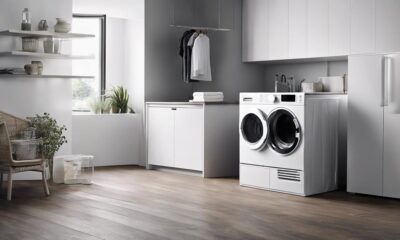
 Vetted2 months ago
Vetted2 months ago8 Best Condensing Tumble Dryers for Efficient Drying Performance
-

 Expert2 months ago
Expert2 months agoWhich Appliances Are Made in Canada
-

 Expert2 months ago
Expert2 months agoWhere Is Smeg Appliances Made
-

 Vetted2 months ago
Vetted2 months ago15 Best Brand Refrigerator Water Filters to Keep Your Water Clean and Fresh
-

 Vetted2 months ago
Vetted2 months ago15 Best Fruit and Vegetable Washing Machines for Cleaner, Safer Produce
-

 Expert2 months ago
Expert2 months agoHow Many Appliances Can a 1 Inch Gas Line Supply
-
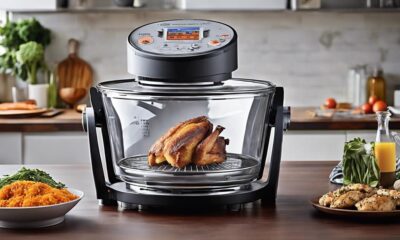
 Vetted2 months ago
Vetted2 months ago15 Best Halogen Ovens for Quick and Efficient Cooking







